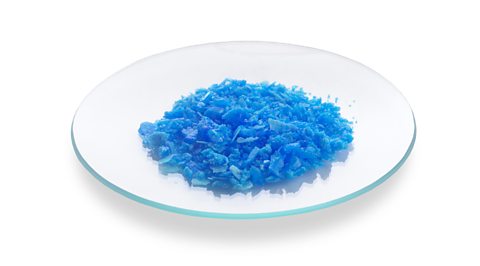Practical activity - investigating the production of salts
It is important in this practical activity to safely use a Bunsen burner and a water bath. This includes the safe use of a range of equipment to separate and purifyTo make ritually clean. mixtures, including filtrationMethod used to separate an insoluble solid from a liquid using a physical barrier such as paper. and crystallisationThe process of producing crystals from a solution by evaporating the solvent..
This outlines one way to carry out the practical using copper(II) oxide powder and dilute sulfuric acid. Eye protection must be worn.
Learn more on salt formation in this podcast.
Listen to the full series on Âé¶čÔŒĆÄ Sounds.
Aims
To investigate the preparation of pure, dry hydratedContaining water of crystallisation, which can be removed by heating strongly. copper(II) sulfate crystals starting from copper(II) oxide.
Method
The reaction
1. Add some dilute sulfuric acid to a small beaker.
2. Add some hot water from a kettle to larger beaker. Place the beaker of sulfuric acid into the hot water to warm up the acid.
3. Add a spatula of copper(II) oxide powder to the acid and stir with a glass rod. Continue adding copper(II) oxide powder until it is in excess and remains as a black powder in the solution.
Filtration
4. Fold a piece of filter paper and put it into a filter funnel. Fit the filter funnel into a conical flask.
5. Add the reaction mixture from the beaker to the filter paper.
6. Collect the filtrate, which is the copper(II) sulfate solution. Dispose of the residue, which is the unreacted copper(II) oxide.
7. Pour the filtrate into an evaporating basin.
Crystallisation
8. Set up a Bunsen burner, tripod and gauze on a heat resistant mat.
9. Put a beaker of water on the gauze and the evaporating basin on the beaker.
10. Heat the water, adjusting the Bunsen burner flame so the water is just simmering.
11. Stop heating before all the water in the evaporating basin leaves the copper(II) sulfate solution.
12. Allow the evaporating basin to cool, then leave it aside for a few days.
Results
Record the appearance of the copper(II) sulfate crystals, including their colour and shape.
Analysis
Hydrated copper(II) sulfate crystals should be blue and regularly shaped. Describe how your crystals compare to this description. Suggest an explanation for any differences.

Evaluation
Question
Explain why the sulfuric acid is warmed at step 2.
Warm acid will react faster than cold acid, helping to ensure that all the acid reacts with the copper(II) oxide.
Hazards, risks and precautions
Evaluate the hazards and the precautions needed to reduce the risk of harm. For example:
| Hazard | Possible harm | Possible precaution |
| Sulfuric acid | Concentrated acid is corrosive and damages skin and clothes | Use dilute sulfuric acid |
| Boiling water bath | Skin burns | Ensure the boiling water bath is stable on the gauze |
| Hot copper(II) sulfate solution spitting out during crystallisation | Damage to eyes and skin | Wear eye protection and avoid standing over the hot apparatus |
| Hazard | Sulfuric acid |
|---|---|
| Possible harm | Concentrated acid is corrosive and damages skin and clothes |
| Possible precaution | Use dilute sulfuric acid |
| Hazard | Boiling water bath |
|---|---|
| Possible harm | Skin burns |
| Possible precaution | Ensure the boiling water bath is stable on the gauze |
| Hazard | Hot copper(II) sulfate solution spitting out during crystallisation |
|---|---|
| Possible harm | Damage to eyes and skin |
| Possible precaution | Wear eye protection and avoid standing over the hot apparatus |